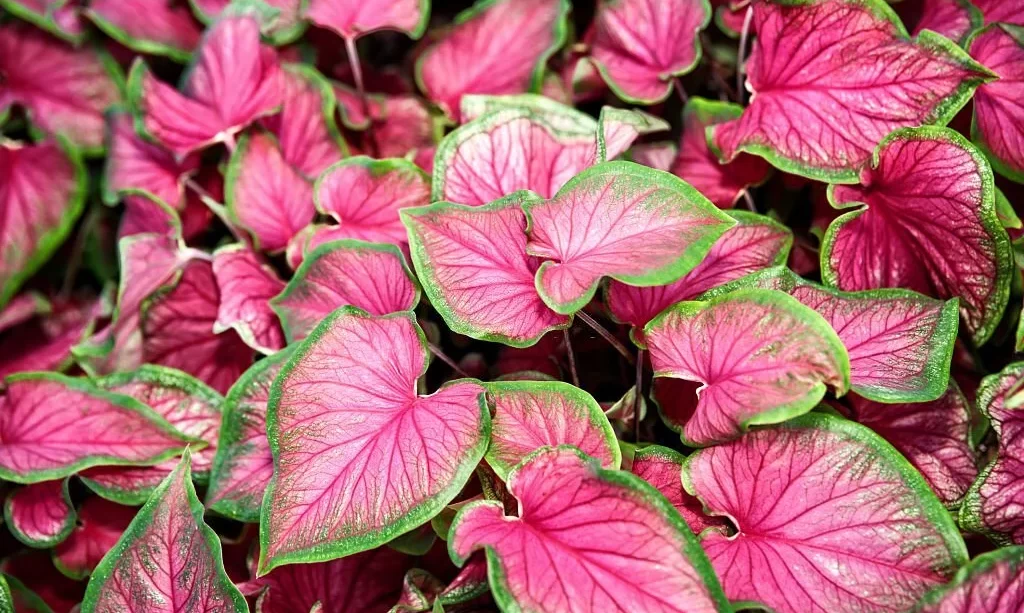Amidst the kaleidoscope of botanical wonders that grace our gardens, Caladiums stand out as a testament to the beauty of foliage. These ornamental plants, known for their striking and vibrant leaves, have captured the hearts of gardeners and plant enthusiasts alike. Yet, a question often arises in the minds of those who cultivate these stunning specimens: Do Caladiums come back? Are they perennial beauties that grace our gardens year after year, or are they fleeting treasures to be enjoyed for a single season? In this exploration, we delve into the intriguing world of Caladiums, seeking to unravel the mystery of their regrowth potential. Whether you’re a seasoned gardener or a budding green thumb, understanding the life cycle of Caladiums will undoubtedly enhance your appreciation for these exquisite plants and guide you in nurturing their enchanting foliage.
- PINK CLOUD CALADIUM – BARE ROOT BULB: This listing includes one bare root bulb of Pink Cloud Caladium, known for its delicate pink leaves with soft green accents, perfect for enhancing the beauty of your garden or containers.
- HARDY IN ZONES 9-11: Ideal for USDA hardiness zones 9-11, this caladium thrives in warm, humid climates. Plant in shaded or partially shaded areas for the best growth and vibrant foliage.
- SOFT PINK AND GREEN LEAVES: The Pink Cloud Caladium features elegant pink heart-shaped leaves with subtle green edges, creating a soothing and beautiful display in any garden bed or container.
- EASY TO GROW AND MAINTAIN: This caladium variety is low maintenance, making it suitable for both novice and experienced gardeners. Simply plant the bare root, water consistently, and enjoy its stunning foliage throughout the growing season.
- VERSATILE FOR GARDENS AND CONTAINERS: Pink Cloud Caladium adapts well to various planting environments, from garden beds to pots, adding a touch of elegant color to shaded spaces.
Caladium Plant Overview
Caladiums, botanical members of the Araceae family, hail from the lush and tropical regions of South America. These captivating plants are renowned for their mesmerizing leaves, which come in an array of vivid colors, patterns, and sizes. The most distinctive feature of Caladiums is their heart-shaped or arrowhead-shaped foliage, which can be flushed with shades of red, pink, green, or white, often adorned with intricate veining that adds depth and character to each leaf.
Caladiums have long been favored as ornamental plants, elevating gardens, patios, and indoor spaces with their dramatic presence. They thrive in warm and humid conditions, reflecting their tropical origins. Their preference for partial to full shade makes them ideal candidates for shaded garden beds, woodland landscapes, and as houseplants to brighten interior spaces.
Beyond their aesthetic charm, Caladiums are known for their distinct growth habit. Many gardeners appreciate their versatility, using them as bedding plants, container specimens, or companions to other shade-loving flora. However, the key question remains: Can Caladiums grace our gardens year after year, or are they beholden to the changing seasons and the whims of weather? In the sections to follow, we delve into the intriguing world of Caladiums to unveil the secrets of their regrowth and perennial potential.
Caladiums as Tender Perennials
Caladiums, with their captivating foliage and tropical allure, are often classified as tender perennials. This classification means that under specific conditions, they can indeed return and grace our gardens for more than one growing season. However, the term “tender” in this context carries significant implications.
The ability of Caladiums to return each year largely depends on the climate in which they are grown. In regions with mild winters and warm, consistent temperatures, Caladiums may exhibit perennial characteristics, regrowing from their tubers each spring. This can give gardeners the delightful experience of seeing their Caladiums resurface with fresh, vibrant leaves, adding a touch of exotic beauty to their outdoor spaces.
Caladium Overwintering Tips
For gardeners residing in areas where winters bring frost and cold temperatures, overwintering Caladiums becomes a crucial step to ensure their survival and regrowth. Here are some essential tips for successfully overwintering Caladiums:
- Lift the Tubers Before Frost: As the temperatures begin to dip in late autumn, it’s time to carefully dig up the Caladium tubers before the first frost arrives. Use a garden fork to gently lift the tubers from the soil, taking care not to damage them.
- Allow Tubers to Dry: After excavation, let the tubers air-dry in a cool, dry place for several days. This drying period helps prevent rot during storage.
- Store Tubers Indoors: Once dried, store the Caladium tubers indoors throughout the winter. Choose a location with temperatures between 50°F and 55°F (10°C to 13°C). Avoid storing them in excessively warm or humid conditions.
- Use Proper Storage Containers: Place the dried Caladium tubers in containers filled with peat moss, vermiculite, or dry sand. Ensure that the tubers are not in direct contact with each other to prevent potential rot.
- Check Periodically: Periodically inspect the stored tubers during the winter to ensure they remain firm and free from signs of mold or decay.
- Replant in Spring: As the frost-free days return in spring, typically after the last frost date in your area, it’s time to replant the Caladium tubers. Choose a well-prepared garden bed or container with appropriate soil and partial to full shade, and plant the tubers with the eyes (growing points) facing up.
By following these overwintering tips, gardeners in colder climates can encourage Caladium regrowth and enjoy the vibrant foliage year after year. While this process requires some effort, the reward of seeing these tropical treasures return each spring is well worth it, adding a touch of exotic allure to gardens even in regions with challenging winters.
Caring for Caladiums in Warmer Climates
In regions with milder winters and consistently warm temperatures, the care of Caladiums can differ from that in colder climates. Here are some essential tips for tending to Caladiums in warmer regions:
- Partial Shade: While Caladiums thrive in shade, they may appreciate some dappled sunlight in cooler parts of the day in warmer climates. Be cautious not to expose them to harsh, direct sun, which can scorch their delicate leaves.
- Adequate Moisture: Warmer climates often mean more evaporation and drying of the soil. Ensure that Caladiums receive consistent moisture, keeping the soil consistently damp but not waterlogged. Mulching can help retain moisture.
- Fertilization: Regularly feed Caladiums with a balanced, slow-release fertilizer to support their lush foliage. Follow the recommended application rates on the fertilizer packaging.
- Watch for Heat Stress: In high-temperature regions, Caladiums may experience heat stress, which can cause leaf burn or wilt. Providing ample shade during the hottest parts of the day and maintaining consistent soil moisture can help mitigate these effects.
Common Challenges and Solutions
Despite their beauty, Caladiums can face challenges that gardeners should be aware of:
- Tuber Rot: Excessive moisture can lead to tuber rot. Ensure proper drainage and allow the soil to dry slightly between watering to prevent this issue.
- Pest Infestations: Caladiums can be susceptible to pests like aphids and mites. Regularly inspect the plants for signs of infestations and treat with appropriate methods, such as neem oil or insecticidal soap.
- Diseases: Fungal diseases, such as leaf spot, can affect Caladiums. Provide good air circulation, avoid overhead watering, and remove and destroy affected leaves to prevent the spread of disease.
Conclusion: Cultivating Beautiful Caladium Displays
In the tapestry of garden flora, Caladiums stand as exquisite pieces of artistry, painting our outdoor spaces with their vibrant foliage. Whether you’re in a warmer climate where they can flourish year-round or in a colder region necessitating careful overwintering, these plants have the potential to grace your garden with their lush beauty season after season.
Understanding the nuances of Caladium care, from selecting the right location to overwintering or providing shade in warmer climates, empowers gardeners to cultivate captivating displays of these tropical treasures. With diligence and attention to their specific needs, you can create a canvas of Caladiums that enchants and captivates, making your garden a place of vibrant beauty and botanical wonder. Whether they return each year or make a seasonal appearance, the allure of Caladiums remains undeniable, adorning our gardens with their unique charm and color.




